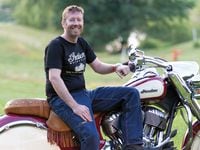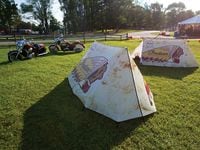It's one thing to write a new story, to start with a blank sheet and create something fresh from the ground up. This is how Polaris built its Victory brand, meeting with considerable success. This isn't easy—not by a long shot—but there's a certain freedom in doing things on your own terms, without history weighing a project down. Reviving the iconic Indian Motorcycle line—Polaris' second motorcycle act—is something different altogether. Not only does the company have to create a new generation of compelling, marketable Indian motorcycles, but it also has to tend to all the memories, desires, and expectations—both good and bad—consumers inevitably associate with America's oldest motorcycle brand. No easy job there.
The bulk of this responsibility rests on one person’s shoulders: Gary Gray, Polaris’ product director for motorcycles. To better understand the challenges Polaris has faced reviving the Indian name, and also to appreciate the unique opportunities this project affords, we joined Gray for a weekend-long immersion in all things Indian at AMA Vintage Motorcycle Days in Lexington, Ohio. Indian was the featured marque at this year’s event, so in addition to enjoying a blue-ribbon collection of antique Indian motorcycles from around the nation, we also watched vintage Indian motorcycles at speed on the Mid-Ohio race course (including one ridden by Gray himself), met with Indian enthusiasts young and old, and rode new and classic Indians side by side, which all contributed to a deep and rich understanding of how Gray relates to this storied brand.
You could say Gray has been training for this job his entire career. He has been with Polaris 20 years, with 19 of those years spent dedicated to motorcycles. Gray was one of the first recruits to the Victory team: “The day I started with the motorcycle group,” Gray remembers, “all we had was one industrial design sketch and one mule vehicle with a competitive motor and adjustable chassis. That was it. But I had been an avid motorcyclist my entire life, so it was nirvana to me.”
Starting with just that one sketch and solitary test mule, Gray and the rest of that team built Victory into the second-biggest cruiser company in the world, selling more cruisers, baggers, and tourers than everyone but Harley-Davidson. But this is where Victory seems destined to stay. No matter how good Victory motorcycles are—and the latest crop is very good—competing with Harley-Davidson is ultimately a brand fight, not a bike fight. That’s where Indian enters the picture.
Polaris leadership considered acquiring Indian many times before finally pulling the trigger in April 2011. Its motorcycle group was completely restructured to accommodate both brands, and Gray was given the Product Director title along with the responsibility for charting a new future for the historic—and historically troubled—Indian brand. “That was an honor,” Gray recalls. “And terrifying at the same time.”
First, Gray and his team got grounded with a deep dive into Indian’s past. “The first thing we did,” Gray says, “is jumped on then-current [Kings Mountain] Indians and went on what we called ‘the Indian heritage tour.’ We visited a collector in Iowa and rode everything he had: Fours, Scouts, Chiefs, from the 1920s through ’40s. Then we went to the National Motorcycle Museum in Anamosa [Iowa] and just absorbed Indian’s history there.
“That was where we had to start,” Gray continues. “We had to pick up someplace where the brand left off, when it was still truly Indian, and work forward from there. If we couldn’t make that connection to Indian’s past, we would be lost.”
Gray read stacks of books and studied everything he could about the original Indian “motocycles,” burying himself in minutia like how they ribbed the floorboards, what patterns they used for grips, and the finer points of engine architecture. At the same time, the team polled consumers to see what they remembered about old Indians and how they connected with the brand. Then Gray compiled a list of everything he thought was important to the Indian brand and everything consumers thought was important as well. Now he had a starting point and a good idea of what the first bike—the Chief—needed to look like.
They started with the motor, designing what would eventually become the Thunder Stroke 111 V-twin. This wasn’t easy. “When I told the engineers we needed a downward-firing exhaust because Indian’s V-twins always had a downward-firing exhaust, they just shook their heads and said, ‘It’s not a flathead. You can’t do that,’” Gray remembers. “I said, ‘I don’t care. We’ve always had parallel pushrod tubes and always had downward-firing exhausts. Those are two of the most important elements that connect this engine to our past, so figure it out.’”
To their credit, Gray says, the engineers did figure it out. “For any other product, they would have said ‘no way,’” Gray says. “But with Indian, it’s like the brand tells the engineers what they have to do. From that standpoint, it was one of the easiest projects I’ve ever done.”
This obsession—compulsion, even—to honor the Indian brand permeates everything Gray does. “That’s why I’m here racing,” says Gray, who competed at Mid-Ohio on an antique Indian Sport Scout in the Class C Hand Shift class. “I’m horrible at it, but somebody’s gotta keep racing these bikes and give something back to the brand. For so many years, other companies just took from the brand, and it’s like a bank account. Eventually it’s going to be gone. We’ve gotta start putting something back, and I feel like we’re doing that now, by keeping this history alive and at the same time by building new bikes that are better, more reliable, and more innovative than anything else on the market now.”
It won’t be an easy journey from the bottom back to the top, but under Gray’s steady stewardship Indian certainly is moving in the right direction, faster than most of us thought possible. And this is just the beginning of the story, Gray is quick to point out.
“The first challenge has been to connect to the past, and that’s been successful,” Gray says. “Now we have to push the Indian brand forward and make it even more modern and more contemporary than what we’re doing today. That’s the next challenge, and I want to do it right. I want people to say, ‘These guys figured it out. These guys got it right. These guys didn’t f—k Indian up.’”
Two surviving members of Indian’s original “Wrecking Crew” race team, Bobby Hill (left, aged 92) and Bill Tuman (right, aged 93), served as grand marshals of this year’s AMA Vintage Motorcycles event. Tuman, best known for winning the last single-day AMA Grand National Championship in 1953—incidentally, Indian’s last AMA Grand National number-one plate—won a total of five GNCs between 1947 and ’55. Hill won the AMA national championship in 1951 and ’52 and America’s biggest race, the Daytona 200, in 1954. Like so many racers of their day, Tuman and Hill got their start racing Army-surplus Indian motorcycles they built and tuned themselves. “It was quite a challenge to win races back in our time,” Tuman remembers. “Indian was a little bit of the underdog back then because they were less well supported than our competition [Harley-Davidson]. But we stayed with our Indians and made them winning motorcycles.”
With extra chrome adorning the signature fat fenders plus added accouterments like a windscreen, spotlights, and chrome-riveted saddlebags, the optional Roadmaster touring package transformed the standard Chief into the most opulent motorcycle of the booming post-war period, perfect for returning vets with cash-lined pockets and plenty of wide-open countryside to explore.
Although some think it’s sacrilegious to consider a classic American cruiser with anything but a V-twin motor, Indian’s premier pre-war motorcycle was powered by a longitudinally mounted, air-cooled inline-four. Known as “The Duesenberg of Motorcycles,” the luxurious 441 featured the same full-fendered styling as the Chief but centered on a 1,300cc flathead four that produced 40 hp—enough to propel its 569-pound chassis to a claimed 95 mph top speed.



















/cloudfront-us-east-1.images.arcpublishing.com/octane/QSTCM6AVEZA5JJBUXNIQ3DSOF4.jpg)
/cloudfront-us-east-1.images.arcpublishing.com/octane/U4I7G625B5DMLF2DVIJDFZVV6M.jpg)
/cloudfront-us-east-1.images.arcpublishing.com/octane/B6XD6LS6IVCQPIU6HXDJSM3FHY.jpg)
/cloudfront-us-east-1.images.arcpublishing.com/octane/ICL63FEDDRDTTMINYICCEYGMDA.jpg)
/cloudfront-us-east-1.images.arcpublishing.com/octane/FCGZHQXRBZFLBAPC5SDIQLVF4I.jpg)
/cloudfront-us-east-1.images.arcpublishing.com/octane/WNOB6LDOIFFHJKPSVIWDYUGOPM.jpg)

/cloudfront-us-east-1.images.arcpublishing.com/octane/X33NU3E525ECRHXLNUJN2FTRKI.jpg)
/cloudfront-us-east-1.images.arcpublishing.com/octane/6KKT5NNL2JAVBOXMZYS5ZO76YA.jpg)
/cloudfront-us-east-1.images.arcpublishing.com/octane/J5RKG5O455GMPGQRF2OG6LRT7A.jpg)
/cloudfront-us-east-1.images.arcpublishing.com/octane/GX2CIZKQVRH2TATDM26KFG2DAE.jpg)
/cloudfront-us-east-1.images.arcpublishing.com/octane/ZWIDYSAKQZHD5BHREMQILXJCGM.jpg)
/cloudfront-us-east-1.images.arcpublishing.com/octane/CYUHJZCTSJCH3MRAQEIKXK7SCQ.jpg)
/cloudfront-us-east-1.images.arcpublishing.com/octane/LKOFINY56FCXJCANJ5M7ZDQUBY.jpg)
/cloudfront-us-east-1.images.arcpublishing.com/octane/4NBPDACMWJH63JQYJVK3QRBDZI.jpg)
/cloudfront-us-east-1.images.arcpublishing.com/octane/KKHQHRR3FJGX7H2IPU6RALMWG4.jpg)

/cloudfront-us-east-1.images.arcpublishing.com/octane/5IOFS5JAE5FOXMNA23ZRAVVYUU.jpg)
/cloudfront-us-east-1.images.arcpublishing.com/octane/CGXQ3O2VVJF7PGTYR3QICTLDLM.jpg)

/cloudfront-us-east-1.images.arcpublishing.com/octane/OQVCJOABCFC5NBEF2KIGRCV3XA.jpg)
/cloudfront-us-east-1.images.arcpublishing.com/octane/OPVQ7R4EFNCLRDPSQT4FBZCS2A.jpg)
/cloudfront-us-east-1.images.arcpublishing.com/octane/YBPFZBTAS5FJJBKOWC57QGEFDM.jpg)
/cloudfront-us-east-1.images.arcpublishing.com/octane/W5DVCJVUQVHZTN2DNYLI2UYW5U.jpg)